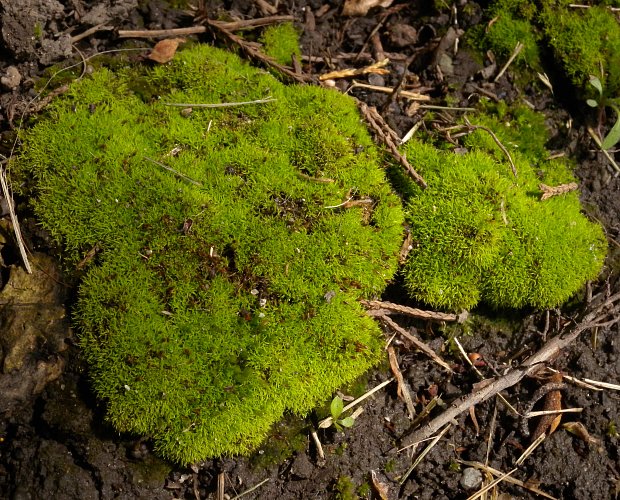
Each leaf has a midrib (costa) that extends to its tip or slightly beyond its tip; when the latter occurs the leaf tip tapers to a short narrow point (cuspidate). The base of each leaf clasps the stem. The lower surface of each leaf has a rounded keel where the midrib occurs. When the foliage of this moss becomes dry, the leaves will curl inward from their tips and become more inrolled along their margins; the dried leaves become more crinkly overall and they have a tendency to corkscrew. With the return of moisture, they straighten out and become more smooth, resuming their former positions along the stem. If an individual moss plant remains robust and healthy, it will eventually terminate in a single spore-bearing capsule that is held on a more or less erect stalk. This usually happens during autumn or spring, but it can occur during other times of the year. The stalk (seta) is typically 3-8 mm. long, pale yellow or yellowish green, terete, and smooth-textured. However, there is an uncommon variety of this moss species (var. longiseta) that can produce a stalk up to 30 mm. long.
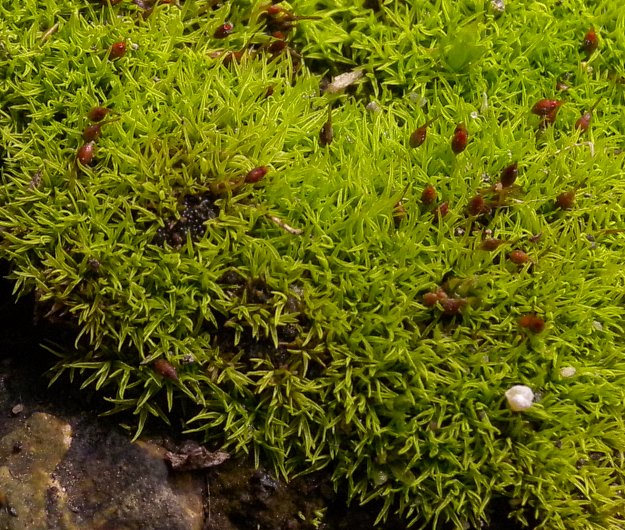
The spore-bearing capsule is held erect or at a slight inclination from the stalk. The capsule body is 1.0–1.5 mm. long, oblongoid-ellipsoid in shape, light green to deep brown (depending on its maturity), and hairless. At the apex of capsule body, there is a strongly beaked lid (operculum) about 0.5 mm. long that eventually falls off the capsule body to release the tiny spores. These spores are distributed primarily by the wind. The upper rim of the capsule body has a ring of tiny yellow to brown teeth (peristome). At the base of the stem, there are fibrous rhizoids (non-vascular roots) that extend into the ground, holding the moss plant in place. On rare occasions, some rhizoids will develop tuber-like gemmae (bud-like bodies of tissue) that can develop into independent clonal plants. These gemmae can remain dormant in the ground, but come to life, even after the mother plant dies (Reese, 1988).
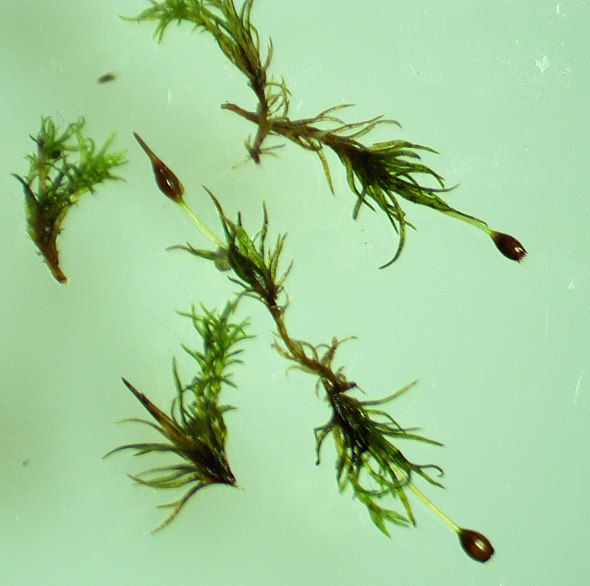
Cultivation: This moss is a short-lived perennial plant with evergreen foliage that prefers partial sunlight to light shade, moist to mesic conditions, cool to average temperatures, and some protection from prevailing winds. It is usually found on exposed ground soil containing loam, clay, gravel, or sand, although it also occurs on thin soil over rocks. Calcareous or slightly alkaline soil is preferred. The growth period occurs primarily during the cool weather of spring and autumn, and to a lesser extent during rainy periods of summer and periods of above-freezing temperatures during the winter. During hot dry spells of the summer, this moss becomes dormant or it can die back, especially if it has much exposure to the summer sun. As compared to other mosses, it has above-average tolerance to dry heat and sunlight.
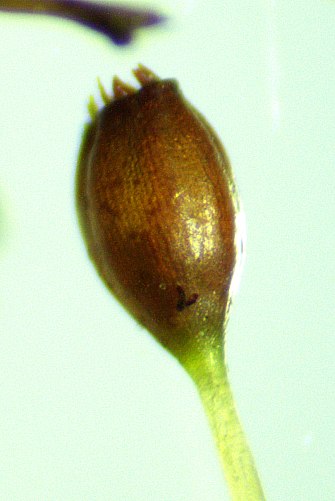
Range & Habitat: The native Pigtail Moss (Weissia controversa) has been found in scattered counties throughout Illinois (see Distribution Map), especially in the NE and southern two-thirds of the state. Because moss species are undercollected, it may occur in every county of the state. Pigtail Moss is a common, somewhat weedy species that is often found on exposed soil in disturbed habitats, although it also occurs in higher quality natural areas. In Illinois, habitats include hill prairies, barren rocky bluffs, north-facing wooded slopes, partially shaded ground in woods, limestone outcrops along creeks, shaded stone walls, shaded soil banks, roadside embankments, abandoned quarries and mining sites, cemetery ground, city parks, vacant lots, fields, pastures, border areas between parking lots and shrubbery, and miscellaneous waste areas. Pigtail Moss is found across large areas of North America, Eurasia, and other continents.
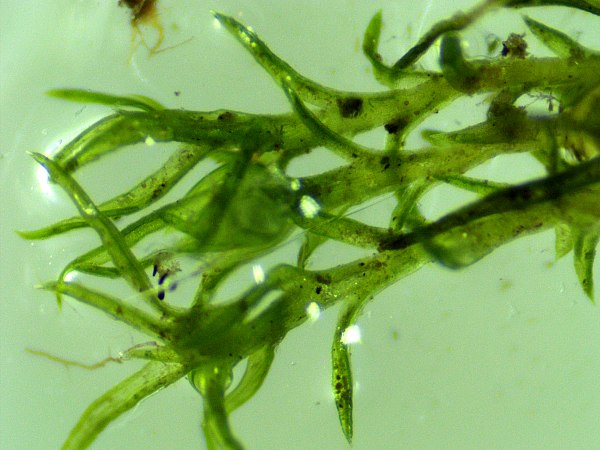
Faunal Associations: Earthworms spread the spores of Weissia mosses, including probably Pigtail Moss (Weissia controversa), to a minor extent because these spores are able to pass through their gullets and remain viable in earthworm castings (Van Tooren & During, 1988).
Photographic Location: Some photographed plants were growing on a shaded wall made from cloth bags of dirt near downtown Urbana, Illinois, while other photographed plants were growing on exposed ground soil between a parking lot and nearby shrubbery in partial shade within the same city. Close-up photos of this moss were taken indoors using a microscope.
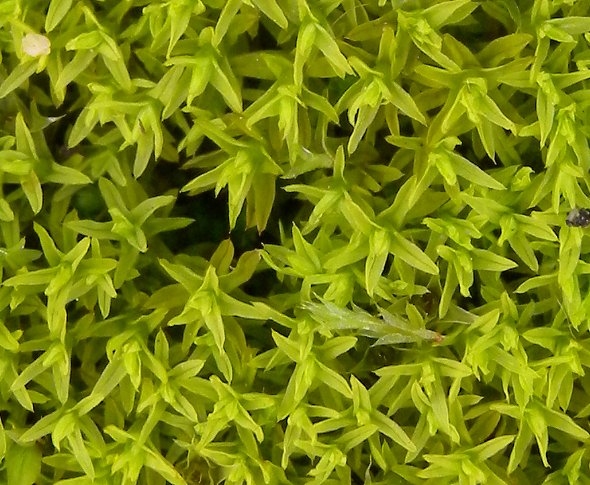
Comments: Pigtail Moss (Weissia controversa) is relatively easy to identify because of its bright yellowish green or lemon-lime leaves. Other mosses are typically light green to dark green, but they lack the distinctive yellowish or lemon-lime tint of their leaves. The leaves of this moss are more narrow than most mosses (narrowly lanceolate to linear-lanceolate) and they are average in size (1-2 mm.). It produces fairly typical spore capsules, but the stalks of these capsules are shorter in length than average. In a dried state, the leaves become rather crinkled, incurved, and curly in appearance, hence the common name "Pigtail Moss." Other common name for this moss include Green-tufted Stubble Moss, Green-cushioned Weissia, and Controversial Weissia. Obsolete scientific names include Acaulon wolfii, Weissia viridula, and Weissia wolfii. See Crum & Anderson (1981) and McKnight et al. (2013) for more information.